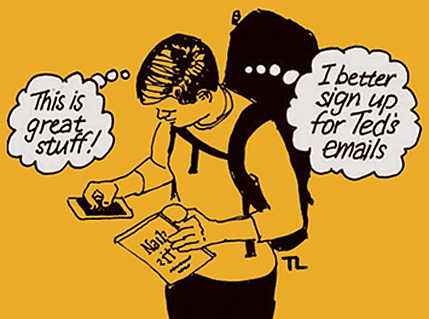Five steps to take when your client base dries up

This post was inspired by a conversation I had with a client a few weeks ago just as Seattle began to get serious about Covid-19. We were having coffee and talking about the effects of the virus on freelance work. It dawned on me that an easy to use action plan would be a great subject for a post.
No clients, no gigs, no work… and here comes the fear.
Action is required here. You know you must take action. But somehow you can’t.
Lots of things get in the way of taking action when your income is threatened. But in my experience, the best way to ensure you take the action that’s required is to have a set of manageable steps you can use – steps that will produce immediate results.
Knowing you have an easily accomplished action plan, a plan that can rekindle your excitement about work, will reduce your fears and give you the confidence you need to actually take action. And this is important: When you reframe your fear as excitement, it redirects your anxiety into positive action.
Five steps for immediate results
1. Make a list of current and past clients.
2. Pick five who are most likely to need your help.
3. Review and make notes on your previous experiences with each of them.
4. Make a list of how you could help them, and get excited about the possibilities.
5. Pick the three most promising; call them. Don’t ask if they need help; ask for their thoughts on your ideas.
Now you have a plan. As you compile your notes for each call, you’re gaining insights that will give you logical reasons to propose new work. They’re logical reasons for success, that in themselves will lessen your anxiety and allow your excitement to grow.
So let’s make that first call.
Call script
Before you call, take a moment to remember this: You’re not making a cold call. You’re renewing a relationship with a client who has needed and appreciated your help before.
When you call, start your conversation like this.
“Hi, Jamie. Got a minute?
I was thinking about the project we did together last fall, and it occurred to me that… (use your best idea from your notes). Is that something you’d find helpful?”
Now they have to reply to your specific idea, because the basic rules of polite discourse require that they respond.
Listen carefully to their response. And just so they know you’re listening – and not just pushing your agenda – repeat what they have to say about your thoughts. Repeat it whether they like your idea or not. Remember, you’re not looking for an “A” grade on your idea; you’re looking for a gig.
So say something like this.
“I see. So, given where you are now, that idea wouldn’t be beneficial. Got it. Is there another direction that could be a help to you?”
The conversation
Now, the very fact that they’ve responded to your idea means you’re engaged in a conversation – so no matter what happens on this call, your client will remember you were interested in them. That your call was all about them, their business, their concerns, their success… and, yes, how you could help.
Notice I said call, not email or text. This is important. Speaking in person allows you to listen to their response and adjust in the moment; it’s personal. Emails and texts lack clues like tone of voice that are keys to understanding how to navigate a situation. There’s nothing better than an actual conversation for developing the kind of connection that can result in renewing your relationship and possibly acquiring new work. You can use text or email to schedule a call, but not to avoid calling.
Theoretically, a video call would be even better than voice. The downside is that the process of setting up a video call takes the immediacy out of the connection.
Ask, don’t tell
Notice I said, “Ask them for their thoughts on your ideas.” This is very important to remember as you’re making the call. Why? Because once you’ve spent the time reviewing past work and thinking about what else you could do for them, you can easily fall into the trap of wanting to tell. People – and this applies to me just as much as anyone – would rather be asked than told. Talking too much is a trap we can all fall into.
I’m a talker. I’m a storyteller. It’s a skill that has served me well. But when I’m anxious I tend to talk too much. So I remind myself before that all-important call: “Ask, don’t tell.”
And it turns out it’s not just me who has a tendency to ramble on. We all suffer from talking too much, especially when we’re nervous.
So I make “ask, don’t tell” one of my notes to myself before a call like this.
Fear keeps us from action
Why don’t I take action? I know I need to do something, but somehow I can’t. What’s going on here?
You know how it is. You’re doing great work. Everything is great. You feel respected for your contribution. You’re able to pay your way and feel in control of your life… and all of a sudden the ride’s over. The work stops coming.
You enjoy the break for a while. Sleep in; revel in the freedom of being out to coffee with friends in the mornings. But then the fear begins to creep in. It’s hard to relax when the coffer is shrinking and payments are due. Your balance of funds dwindles. It’s time to pay the rent. Your partner reminds you of your responsibilities. Yikes! It hits you, and that special spell that denial can cast is broken: You need to get some work.
Somehow you’re frozen
Your worst fears could be true. Maybe it really was just a fluke that clients liked your work. Impostor syndrome is finally catching up to you. You think, “I always knew I wasn’t really that good. That’s why I don’t have any work now.”
Your anxiety rises. You can’t stop thinking, “It’s something I said. Something I did. Maybe I was charging too much. Maybe I shouldn’t have…”
The real problem is that when work dries up, we don’t feel necessary. Our fear is driven by the feeling that we’re not actually needed. But remember that all the people you’ve worked with did need you; they just may not know they need you again now.
Action reduces fear, and produces results
I’ve used these five steps often myself, and recommended them to many of my consulting clients. In my experience, they always reduce fear, and they always lead to new work. Why? Researching for these calls to past clients, people you’ve worked with before, will first of all remind you why they needed you. Even though you haven’t heard from them recently, there will be a comfort simply in renewing the connection. The simple act of the conversation itself will reduce your fear, build the relationship and usually lead to new work.
I’ve learned that fear is an active state that dominates our prefrontal cortex. Excitement is also an active emotion that can grab the attention of our conscious mind. The trick is in using simple, planned steps to transition from fear to excitement – excitement at the possibility of new business, and real proof that you’re needed by clients after all.
If you need individual help adapting to this new world sign up for consulting sessions here>>



6 Comments
Excellent, really excellent article Ted. As always you capture the feelings and find words to express them, and this helps us all. Thank you. Stay well. Matthew x
Thanks Matthew, Let’s talk. What’s your availability later in the week?
Was told to read this article by a colleague once I was laid off by a client AFTER they hired me full time. Getting my entrepreneurial mind back together. Thanks, Ted.
Sometimes a nudge from a friend is all we need to take positive action. Thanks for your comment, Kelly.
Hi Ted,
I was actually in the process of this very process before the Corona hit. Unfortunately many of my potential leads have been hit hard as well. Thank you for your article, maybe a Part Two is in order?
— Emilie
Part 2, Expand your reach. Create a bigger circle of potential new business by examining your past work and listing potential clients that your skills and expertise can help. List the ways your experience can be of help in this time of struggle. Use your social media to expand your reach. Use your network as source of ideas and support. Join our Mentor Morning group on Zoom this Saturday, 3/28, 10-noon…https://tedleonhardt.com/ted-events/mentor-morning-kindness-and-cooperation/